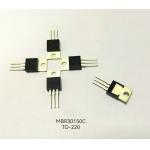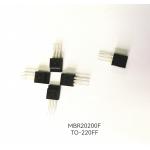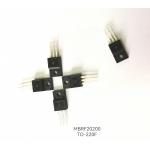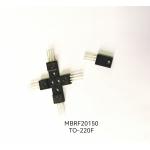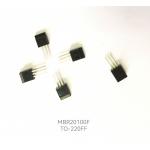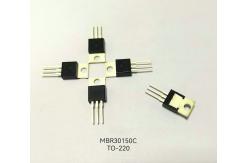Low Power Loss Schottky Diodes High efficiency High current
resistance
MBR30100.pdf
Schottky diode is a fast repair diode, which is a power
consumption, fast semiconductor component. Its obvious
characteristics are that the reverse recovery time is very short
(can be as small as a few nanoseconds), and the forward pressure
drop is only about 0.4V. Schottky diodes are mostly used as
high-frequency, low-voltage, high-current rectifier diodes,
freewheeling diodes, and maintenance diodes. They are also
effectively used as rectifier diodes and small data signal
detection diodes in power circuits such as optical fiber
communications. It is commonly used in secondary switching power
supply rectification and high voltage power supply rectification of
color TV. The Schottky diode uses the metal-semiconductor junction
as the Schottky barrier to achieve the actual effect of
rectification, which is different from the P-N junction formed by
the semiconductor-semiconductor junction in general diodes. The
characteristics of the Schottky barrier make the on-off current of
the Schottky diode lower, and can increase the conversion rate.
Schottky diodes have an extremely low on-off operating voltage. A
general diode will generate a current of about 0.7-1.7 amperes when
the current passes through it, but the current of the Schottky
diode is only 0.15-0.45 amperes, which can improve the efficiency
of the system.
Features
1. Common cathode structure
2. Low power loss, high efficiency
3. High Operating Junction Temperature
4. Guard ring for overvoltage protection,High reliability
5. RoHS product
Applications
1. High frequency switch Power supply
2. Free wheeling diodes, Polarity protection applications
ABSOLUTE RATINGS (Tc=25°C)
Parameter | Symbol | Value | Unit |
Repetitive peak reverse voltage | | | |
Maximum DC blocking voltage | | | |
Average forward current | TC=150°C (TO-220/263/252 )TC=125°C(TO-220F) | per device per diode | | | |
Surge non repetitive forward current 8.3 ms single
half-sine-wave (JEDECMethod) | | | |
Maximum junction temperature | | | |
Storage temperature range | | | |

